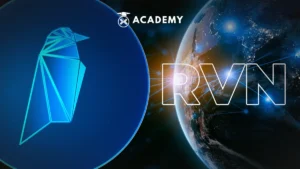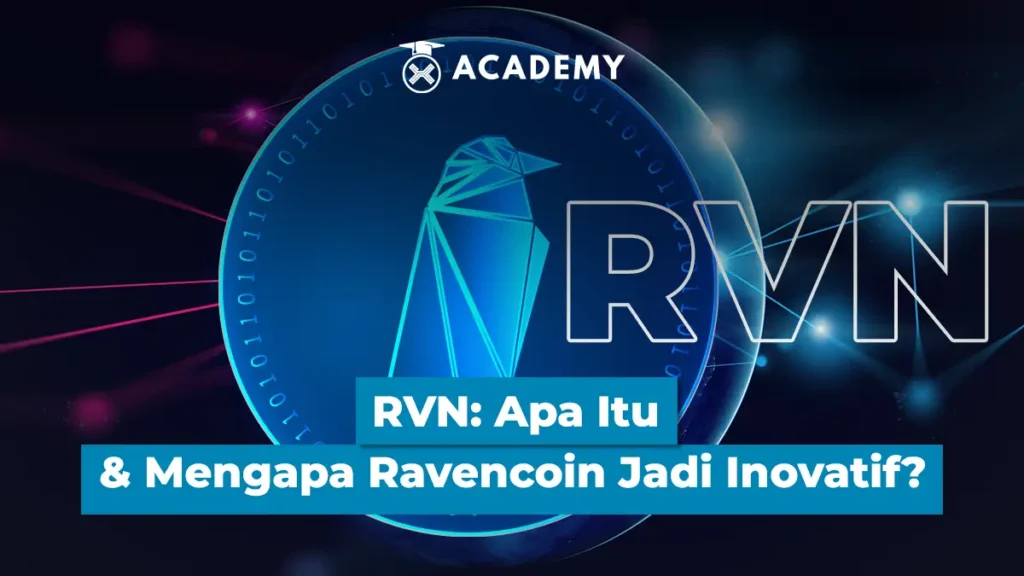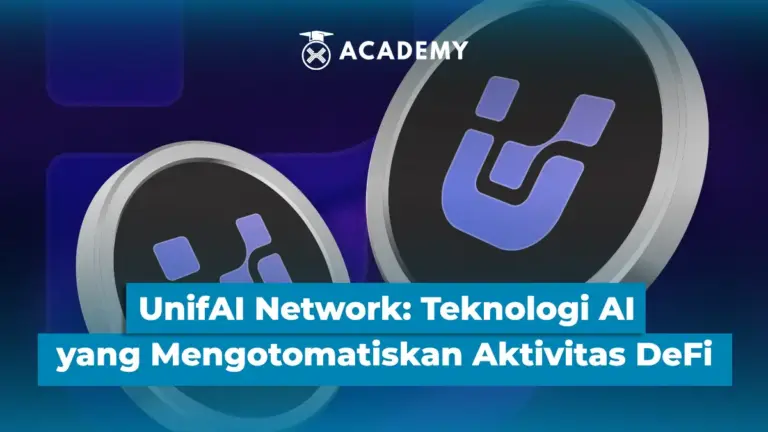Ravencoin is an open-source blockchain designed specifically to facilitate fast and secure transfers of digital assets.
Although often compared to Bitcoin, Ravencoin comes with its own advantages, such as a more inclusive and efficient mining algorithm.
In this article, we will discuss in more depth what RVN is, how it works, what its advantages are, and how the mining process can be carried out.
What is Ravencoin (RVN)?

Ravencoin (RVN) is a peer-to-peer (P2P) blockchain network specifically developed to facilitate fast and secure digital asset transfers.
Unlike Bitcoin, which focuses on digital currency transactions, Ravencoin is designed as a platform for tokenizing assets such as tokens, stocks, and NFTs.
Historically, Ravencoin was first introduced to the public on October 31, 2017 before finally being officially launched on January 3, 2018.
This project was developed as a fork of Bitcoin with various optimizations to make the process of issuing and transferring digital assets more efficient.
The Ravencoin whitepaper was written by three influential figures in the crypto community, namely Bruce Fenton, Tron Black, and Joel Weight. Each has a strong background in the financial industry and blockchain technology.
Regarding its main function, Ravencoin allows users to issue and transfer digital assets without the need to use smart contracts like in Ethereum.
With this system, Ravencoin offers a simpler and more efficient solution for anyone who wants to create blockchain-based tokens without additional complexity.
Additionally, since it uses the Bitcoin base code, Ravencoin adopts a proven security model but with some enhancements to make it more suitable for asset transfers.
This makes it an attractive option for those who want to explore the world of tokenization without relying on the Ethereum ecosystem.
People Also Read: Is PoW Outdated? PoS Is Now the New Standard!
How Does Ravencoin Work?
Ravencoin uses a Proof of Work (PoW) mechanism with the KawPow algorithm, which supports inclusive mining, fast transactions, and fair token distribution. Here’s how it works:
1. Consensus Algorithm
Ravencoin uses the KawPow algorithm, which is designed to be more friendly to miners using GPUs compared to ASICs (specialized mining devices).
This algorithm helps keep the network decentralized, as it does not rely on miners with expensive devices that usually dominate networks like Bitcoin.
2. Blocks & Transactions
One of Ravencoin’s advantages over Bitcoin is its faster block generation time, which is around 1 minute. In comparison, Bitcoin takes around 10 minutes for each new block.
With a shorter block time, Ravencoin allows for faster and more efficient transactions, especially in the digital asset tokenization ecosystem.
3. Security & Decentralization
Unlike many other crypto projects that hold pre-mines or ICOs, Ravencoin does not do an initial distribution of tokens to the development team or investors before launch.
This ensures that all RVN tokens in circulation are actually obtained through a fair mining process.
With this approach, Ravencoin emphasizes transparency, security, and stronger decentralization compared to other projects that have a more closed token distribution mechanism.
Ravencoin operates as a blockchain network that adopts the Proof of Work (PoW) mechanism, but with some significant differences from Bitcoin to be more inclusive and efficient in mining and transferring digital assets.
Ravencoin’s Strengths and Weaknesses
As a blockchain designed for digital asset transfers, Ravencoin has several advantages over other platforms. However, like any other technology, there are also some weaknesses that need to be considered.
1. Ravencoin’s Strengths
1.High decentralization
As mentioned earlier, unlike many other crypto projects that pre-mine or ICO before launch, Ravencoin is fully distributed through the mining process.
This means that no party gets an unfair early advantage, so the network remains more transparent and decentralization is better maintained.
1.Fast and cheap digital asset transfers
The next advantage is that Ravencoin is specifically designed to facilitate digital asset transfers with high efficiency.
Compared to other blockchains such as Bitcoin or Ethereum, transactions on Ravencoin are faster with much lower fees, making it an ideal choice for tokenizing various assets.
1.Mining is fairer
By using the KawPow algorithm, Ravencoin allows more people to participate in mining using standard GPUs.
This is different from Bitcoin, which is currently dominated by expensive ASIC devices. With this system, Ravencoin creates a more inclusive and open mining ecosystem for anyone.
1.Guaranteed security
It should be noted that Ravencoin is built on the Bitcoin source code that has been tested and relied on for years.
With various improvements to its system, Ravencoin maintains a high level of security, ensuring that transactions and digital assets in its network are well protected.
2. Ravencoin’s Weaknesses
1.Adoption is still limited
The first weakness is that despite having various advantages, Ravencoin is not as popular as Bitcoin or Ethereum.
This network is still in the development stage and does not have an ecosystem as large as other blockchains so its use is not yet very widespread in various industries.
1.Limited smart contract features
Unlike Ethereum which supports complex smart contracts for decentralized applications (dApps), Ravencoin focuses more on the transfer of digital assets.
While this makes it more efficient, this limitation can be an obstacle for developers who want to build applications with more complex contract logic.
1.High price fluctuations
Like many other crypto assets, the price of RVN can experience quite drastic changes in a short time.
That makes it less stable to use as a means of payment or long-term store of value, especially for investors looking for low-volatility assets.
People Also Read: NiceHash: A Handy Crypto Mining Platform
How to Mine RVN for Beginners
For those of you who want to try mining Ravencoin (RVN), the process is quite simple and can be done with a device that supports GPU. Here are the steps:
1. Prepare Hardware
To mine RVN, you need a GPU that is compatible with the KawPow algorithm, such as an NVIDIA or AMD graphics card. The higher the computing power (hash rate) of the GPU, the greater the chance of getting rewards from mining.
2. Download Mining Software
Choose mining software that suits the GPU you are using. Some popular choices for mining RVN are:
- T-Rex Miner (suitable for NVIDIA GPUs)
- Gminer (can be used on NVIDIA and AMD)
- NBminer (an alternative that also supports various types of GPUs)
Download software from official sources to avoid malware or other malicious programs.
3. Join a Mining Pool
Solo mining is very difficult because of the high competition, so it is better to join a mining pool so that the chances of getting RVN are greater. Some of the best mining pools for Ravencoin are:
- RavenMiner
- 2Miners
- Flypool
After joining, you will be given a mining server address that will need to be configured in the software.
4. Start Mining
Once the hardware, software, and mining pool are ready, you can run the mining software and start earning RVN as a reward.
Make sure you monitor the GPU temperature so that it does not overheat and optimize the power settings for maximum efficiency.
5. Store RVN in a Wallet
RVN mining results need to be stored in a compatible wallet. You can use Ravencoin Wallet (the official wallet) or store RVN on an exchange that supports RVN if you plan to sell it later.
People Also Read: Proof of Importance: What’s the Difference Between PoS and PoW?
Ravencoin vs Bitcoin: What’s the Difference?

Although Ravencoin (RVN) is built from a fork of the Bitcoin source code, the two have fundamental differences in their goals and operational mechanisms. Here are some of the differences:
1. Purpose of Use
Bitcoin is designed as a digital currency for financial transactions and value storage, while Ravencoin is specifically designed for the transfer of digital assets such as tokens, stocks, or NFTs.
2. Consensus Algorithm
Bitcoin uses the SHA-256 algorithm, which is more profitable for miners with ASIC devices, while Ravencoin uses KawPow, which is more friendly to GPU mining, making it more inclusive for individual miners.
3. Block Time and Rewards
Ravencoin has a block time of 1 minute, much faster than Bitcoin which takes 10 minutes per block.
In addition, Ravencoin’s initial block reward was 5,000 RVN, while Bitcoin was only 50 BTC when it was first launched, with a halving mechanism every four years.
4. Smart Contracts and Tokenization
Bitcoin does not directly support asset tokenization without additional smart contracts.
Meanwhile, Ravencoin allows users to create and transfer digital assets directly without the need for smart contracts like in Ethereum.
5. Token Distribution
Ravencoin did not have a pre-mine or ICO so all coins were obtained through the mining process.
On the other hand, Bitcoin also did not have an ICO, but at the beginning there was a large distribution to several parties who were previously involved in the project.
Conclusion
So, that was an interesting discussion about RVN: What is it & Why is Ravencoin Innovative? which you can read in full at the Crypto Academy at INDODAX Academy.
In conclusion, Ravencoin is a blockchain specifically designed for digital asset transfers with a high level of security and low transaction costs.
Compared to Bitcoin, Ravencoin offers a faster transaction process and a mining system that is more friendly to GPU users.
Although its adoption is not as big as Ethereum or Solana, Ravencoin basically has great potential in the asset tokenization ecosystem in the future.
For additional information, you can buy RVN through INDODAX with simple steps. First, register or log in to your INDODAX account at Indodax.com.
After that, make a Rupiah (IDR) deposit using the available payment methods. Next, find the RVN/IDR pair on the INDODAX crypto market and select the purchase option as desired, either at market price or through a limit order.
After the transaction is successful, you can store RVN in the INDODAX wallet or move it to a personal wallet for optimal security.
FAQ
1.What is Ravencoin (RVN)?
Ravencoin is a blockchain designed to transfer digital assets such as tokens, stocks, and NFTs in a more efficient way than Bitcoin.
2.How to get RVN?
RVN can be obtained through mining using GPUs or buying it on exchanges such as INDODAX.
3.What is the difference between Ravencoin and Bitcoin?
Ravencoin focuses more on transferring digital assets, while Bitcoin is used more as a store of value.
4.Does RVN support smart contracts?
No, Ravencoin does not have complex smart contracts like Ethereum, but it can be used to create and transfer digital assets.
5.What is the maximum total supply of RVN?
The maximum total supply of RVN is 21,000,000,000 coins, much more than Bitcoin which only has 21,000,000 coins.





 Polkadot 8.91%
Polkadot 8.91%
 BNB 0.54%
BNB 0.54%
 Solana 4.81%
Solana 4.81%
 Ethereum 2.37%
Ethereum 2.37%
 Cardano 1.35%
Cardano 1.35%
 Polygon Ecosystem Token 2.11%
Polygon Ecosystem Token 2.11%
 Tron 2.85%
Tron 2.85%
 Market
Market


